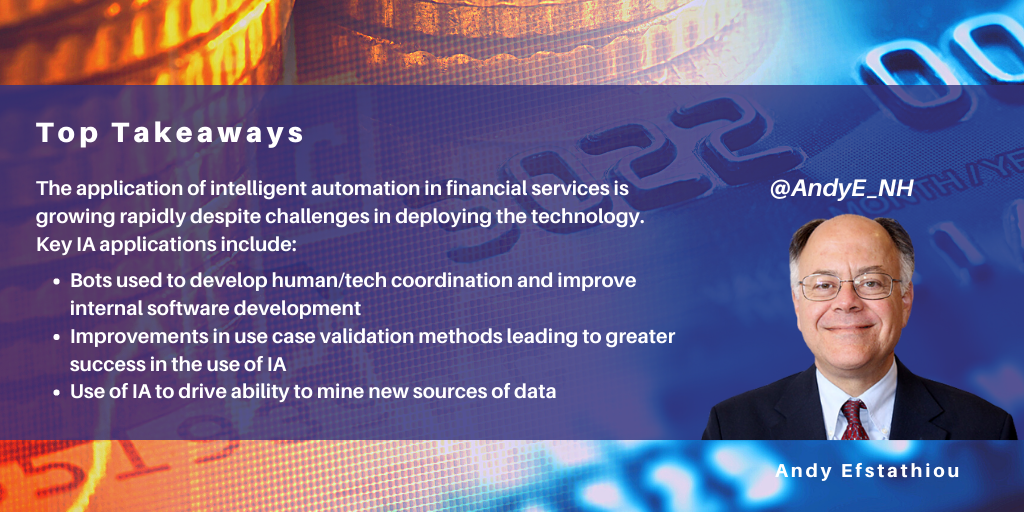posted on Apr 14, 2023 by Andy Efstathiou

In the financial services industry, there was an initial expectation that demand for intelligent automation (IA) would fall off as clients changed platforms and moved to a microservices architecture. Instead, the application of IA in financial services has grown rapidly. The initial evidence from my current study shows that despite challenges deploying the technology effectively, the ability to bring decision making to the line-of-business user at a low cost of implementation makes a compelling value proposition.
Despite its ability to accelerate accurate, transparent process execution, implementing IA effectively is challenging. Key challenges include:
- Use case failure rate: the majority of use cases have not met their promised returns. Most POCs have not been operationalized. Increasingly, ITS vendors have had to build COEs and use case libraries to increase the cost effectiveness of IA projects. Success rates are rising, but only where ITS vendors are able to marry client operational knowledge with industry best practice
- Orchestration of bots: operations is a dynamic environment and bots are unable to reskill or change jobs without advanced orchestration services. Performance degrades rapidly in a poorly orchestrated environment
- Dynamic nature of business processes, including cyclicality, reengineering, and sunsetting: the tempo and structure of operations changes with time, requiring continuing process reengineering and new use case development
- Heterogeneous core banking platforms: most banks today are an amalgam of multiple platforms. Deploying automation across multiple environments and architectures requires process discovery, reengineering, and consolidation.
Despite these challenges, IA activities have taken off because:
- Banks lack sufficient investment capital for full platform replacement
- Bots have benefited from increasing functionality, mostly due to increased AI capabilities, which enable them to deliver greater value. For example, banks need to increase their employee productivity. The AI used for bots has been used to develop human/tech coordination capabilities which have enabled better customer interactions and improved internal software development
- Technology services vendors and banks have improved their use case validation methods, leading to greater success in operationalizing initiatives.
Over the past several years, as automation services have matured, banks have begun narrowing the number of processes they are spending resources on automating. Processes where IA is increasingly applied are:
- Technology development, especially software development
- Customer contact, especially human/bot delivered contact; often focusing on support for independent agents (such as third-party mortgage originators or independent wealth advisors)
- Cyclical processes, such as loan originations/collections, payments, and portfolio due diligence
- Compliance, with a heavy focus on KYC and AML processes
- Data management, especially in mining new sources of data (from social media and third-party data vendors).
IA adoption will continue to grow faster than overall technology adoption in the financial services industry because banks need to move fast to deal with rapidly declining margins and the need to change their business models. Automation vendors are remaining relevant in this developing market by investing heavily in building more AI functionality. Vendors who are struggling are the ones who have failed to embed robust new AI functionality in their offerings. Ultimately, intelligent automation is less about process automation and more about helping banks orchestrate their labor forces and business partners to deliver service to customers.
